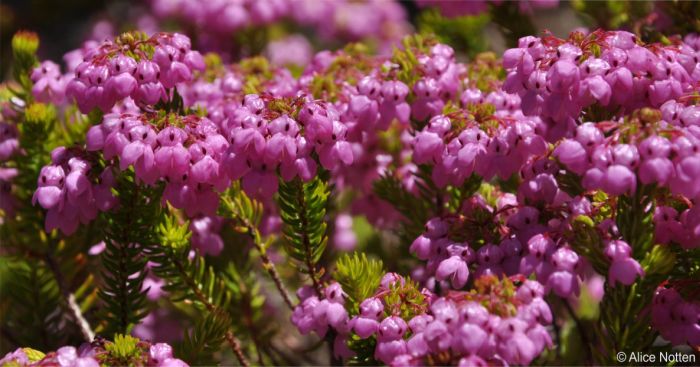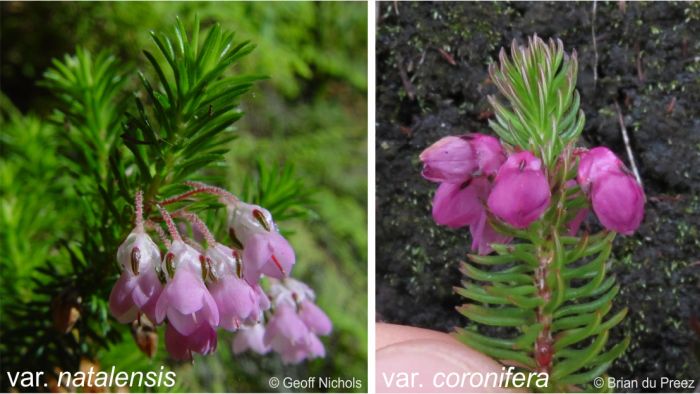Erica cubica var. cubica
Erica cubica L. var. cubica
Family: Ericaceae
Common names: cube heath (Eng.) kubusheide (Afr.)
Introduction
Erica cubica displays a mass of deep pink flowers in early summer.

Description
Description
Erica cubica is an erect evergreen shrub, and grows quite densely, up to ± 450 mm tall. Leaves are linear and hairless, and very variable in size and setting. The branch tips present the flowers in umbels (a group of flowers in an inflorescence where the divergent stalks rise from the same point). The corolla is bell- to funnel-shaped and is about 6 mm long, with conspicuous straight lobes. The sepals are keeled (have a prominent ridge) with the keel tip ending in a point, and the angles formed by the keels make the calyx appear box-shaped. A peculiar hairy point is noticed on the muticous anthers (anthers without appendages). Flowering time is in spring and early summer (September to January).

Erica seriphiifolia and Erica tetrathecoides are closely related and similar to Erica cubica, but Erica cubica differs by having much longer leaves and dense clusters of deep pink, wide open flowers, borne on the tips of the branches.
Conservation Status
Status
Erica cubica is not threatened and is currently allocated the conservation status of Least Concern (LC) by the Red List of South African Plants.

Distribution and habitat
Distribution description
This plant grows happily in seepage areas and marshes and is commonly found on the southern coast on the lower mountain slopes, from mountains near Swellendam in the Western Cape to Vanstadensberg near Gqeberha and along the wild coast in the Eastern Cape into southern KwaZulu-Natal. Scattered populations in a few localities in central and southern KwaZulu-Natal have been described as the variety natalensis. Another variety that occurs near George is also recognised as var. coronifera. The latter has sepals with a long, leaf-like point, and the calyx reaches from three quarters to the height of the corolla, where in the type it is shorter, from two fifths to three quarters the height of the corolla. Also, the leaves in var. coronifera are squarrose (spread widely at nearly right angles to the stem). In the var. natalensis the leaves are more slender and erect to spreading, and the sepals are similar to those of the var. coronifera.

Derivation of name and historical aspects
History
The genus name Erica derives from the Latin word ereiko which means ‘heath’ or ‘broom’. The specific epithet cubica also derives from a Latin word namely cubicus which means ‘cubic’ and refers to the box-like shape of the lower half of the flower.

Erica cubica belongs to the Ericaceae, the heath family. Although the heath genus, Erica, is common through much of Europe, the Mediterranean, the islands of the Atlantic and tropical Africa, it has its highest concentration of species in southern Africa, with over 600 species in the Cape Floristic Kingdom alone. The genus Erica comprises about 800 species, of which approximately 700 species are indigenous to South Africa.
The family Ericaceae contains many well-known (although not indigenous to South Africa) genera such as Rhododendron, Calluna (heather), Vaccinium (blueberries, cranberries, etc.) and Gaultheria (wintergreen).The Ericaceae includes evergreen, deciduous, and sclerophyllous shrubs with a cosmopolitan distribution, found mostly in temperate, warm temperate and montane tropical areas.
Ecology
Ecology
Erica cubica was observed being pollinated by insects, the insects contribute to the pollination process by visiting different flowers.
Ericas are usually small woody shrubs with characteristic ‘ericoid’ leaves which are small and narrow with rolled-under margins, these features help with reducing transpiration (water loss), especially during the dry summers.

Their most outstanding features are the colour of the flowers and amazingly diverse shapes and sizes, the different forms attracting different pollinators. The basic flower shapes of Erica plants are the open or closed bell which may be wax-like, smooth or hairy or extremely sticky which may serve as a protection feature for the plant. The shape of the flowers also determines which pollinators come and visit their flowers, whether birds or insects. Nearly all colours and combinations are found in erica flowers, except blue.
The seeds of ericas can lie dormant and remain viable for long periods in the natural seed bank, most seeds will germinate when environmental conditions become favourable, such as ample moisture levels in the soil and ideal day and night temperature. Erica plants serve as a food source for various animals.
Uses
Use
Erica cubica may be grown as a pot plant provided that the soil medium used is in the acidic range and drains well. This plant can be successfully grown as a companion plant alongside restios (species in the Restionaceae), however other groups of plants are also suitable such as buchus (Rutaceae), proteas, pincushions etc. (Proteaceae) and perennial plant species indigenous to South Africa, particularly the Western Cape.

Growing Erica cubica var. cubica
Grow
Like most ericas, the cube heath prefers soil with an acidic pH ranging from 5.5-6.7 and a sunny position. Ericas can grow in a variety of habitats but always prefer soil with good drainage. Prune the plant lightly after flowering, this will encourage the development of new shoots, pruning will also remove dead or damaged branches. Apply an organic liquid fertiliser such as a fish emulsion when planting in pots. Erica cubica can be grown by taking ± 40-50 mm long cuttings 2 months after flowering, from semi-hardwood, heel or nodal cuttings. Use a rooting medium of fine-milled bark and perlite balls at a 50:50 ratio to improve the chances of successful rooting.
Vegetative propagation of this plant will result in much faster development from a rooted cutting to a young plant, although seed sowing is ideal but usually a slower process before it reaches the seedling stage. Erica cubica can be successfully grown in normal greenhouse conditions and usually roots well when supported by a hot bench maintained at a constant bottom heat of 24°C. Open-air mist spray units can also create ideal conditions when propagating by cuttings, to prevent the cuttings from drying out too quickly or overheating they can be lightly shaded during summer.
Transplant the rooted cuttings into small pots, about 9 cm, and when the roots are well-developed transplant them into half-litre plastic bags containing 7 parts milled bark and 3 parts sand (the same mix as for pots) and water thoroughly. Feed with an organic liquid fertilizer, preferably a fish emulsion type, every 2 weeks and shade lightly for a month, thereafter it can be placed in full sun conditions. The cuttings will be ready for planting after about 3 months, care must be taken not to damage the fine root hairs when transplanting.

Harvest seeds after flowering when the seed capsules have dried, before dropping to the ground. Take a branch with old flowers and tap gently on the palm of your hand. If the seed falls into your hand then collect the stem with old flowers and place them into a paper packet to dry. The old flowers containing the fruits should be dried and then rubbed through a sieve. The resultant mix may be winnowed to separate the seed from the trash.
Sow seeds in autumn (April and May), when the temperature starts to drop naturally. Use seed trays about 100 mm deep, filled with equal parts of river sand and sifted composted bark and ensure that the trays drain well. Use fine river sand to mix with the seeds this will prevent the seeds from being sown too densely. Broadcast the seeds on top of the levelled mix, at this stage, you may cover it lightly with some of the mixed sand. Treatment of the seeds with ‘fynbos smoke’ or smoke extract greatly enhances germination. Water carefully with a fine hose because seedlings will be washed from the tray. Do not expose the seedlings to direct sunlight and rain, over-watering causes damping off The seeds will start to show signs of germination after about 2 months. Transplant young plants into multi-trays or small pots as soon as they reach a height of about 10 mm.
Apply an appropriate organic contact or systemic pesticide to control mealybug and scale insects. Fungal attacks can be prevented by not sowing seeds too densely and by ensuring good air circulation in the propagation unit.
References
- Du Preez, B. 2012. Observation of Erica cubica var. coronifera, Outeniqua Mountains. iNaturalist. Online. https://www.inaturalist.org/observations/10855225.
- Foden, W. & Potter, L. 2005. Erica cubica L. var. cubica. National Assessment: Red List of South African Plants version 2020.1. Accessed on 2023/07/27.
- Bolus, H., Guthrie, F. & Brown, N.E. 1909. Ericaceae. Flora capensis 4(1):2–418.
- Picture This. Erica cubica L. var cubica. https://www.picturethisai.com/wiki/Erica_cubica.html. Accessed: 04/08/2023.
- Pienaar, K. & Smith, G.F. 2011. The southern African what flower is that? An essential guide to garden plants. Struik, Cape Town.
- Plants of the World online. Erica cubica var cubica. https://powo.science.kew.org/taxon/urn:lsid:ipni.org:names:328512-1. Accessed 04/08/2023.
- Potgieter, J. 2023. Observations of Erica cubica. iNaturalist. Online. https://www.inaturalist.org/observations?place_id=any&taxon_id=584767&user_id=outrampsjenny. Accessed 04/08/2023.
- Raimondo, D., Von Staden, L., Foden, W., Victor, J.E., Helme, N.A., Turner, R.C., Kamundi, D.A. & Manyama, P.A. (eds) 2009. Red list of South African plants. Strelitzia 25. South African National Biodiversity Institute, Pretoria.
- Rourke, J.P. 1980. Wild flowers of South Africa. C. Struik Publishers, Cape Town.
- Schumann, D., Kirsten, G. & Oliver, E.G.H. 1992. Ericas of South Africa. Fernwood Press, Vlaeberg.
- Smith, C.A. 1966. Common names of South African plants. Memoirs of the Botanical Survey of South Africa No. 35. Government Printer, Pretoria.
Credits
Benjamin Festus
Kirstenbosch National Botanical Garden
September 2023
Acknowledgements: the author thanks Alice Notten, Geoff Nichols, Brian du Preez and Jenny Potgieter for providing the pictures.
Plant Attributes:
Plant Type: Shrub
SA Distribution: Eastern Cape, KwaZulu-Natal, Western Cape
Soil type: Sandy, Loam
Flowering season: Spring, Early Summer
PH: Acid
Flower colour: Pink
Aspect: Full Sun
Gardening skill: Average
Special Features:
Horticultural zones









Rate this article
Article well written and informative
Rate this plant
Is this an interesting plant?
Login to add your Comment
Back to topNot registered yet? Click here to register.